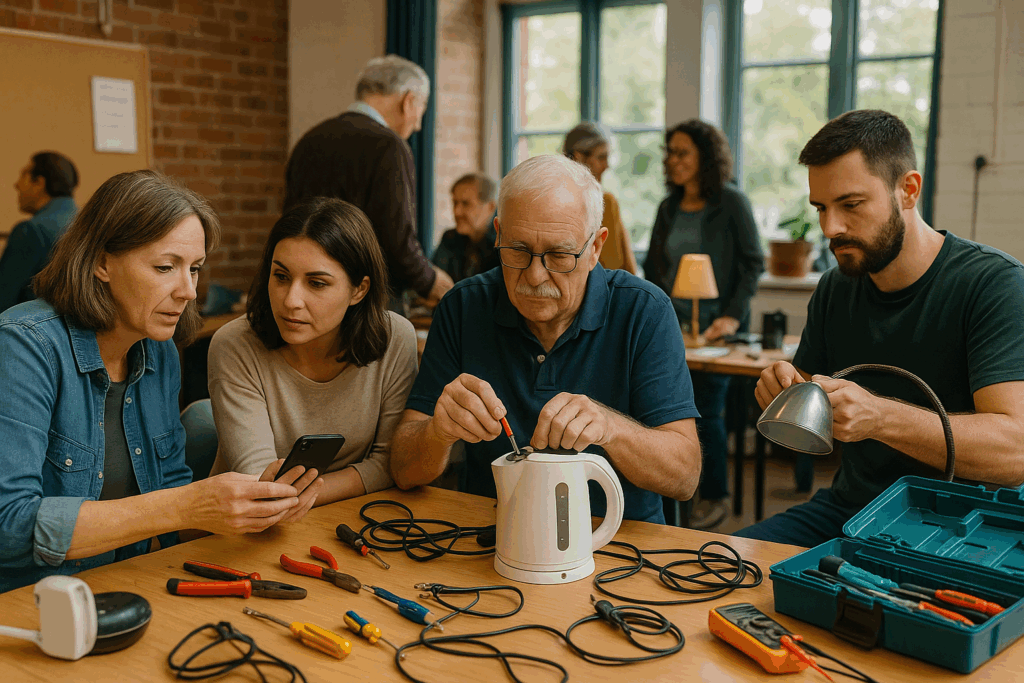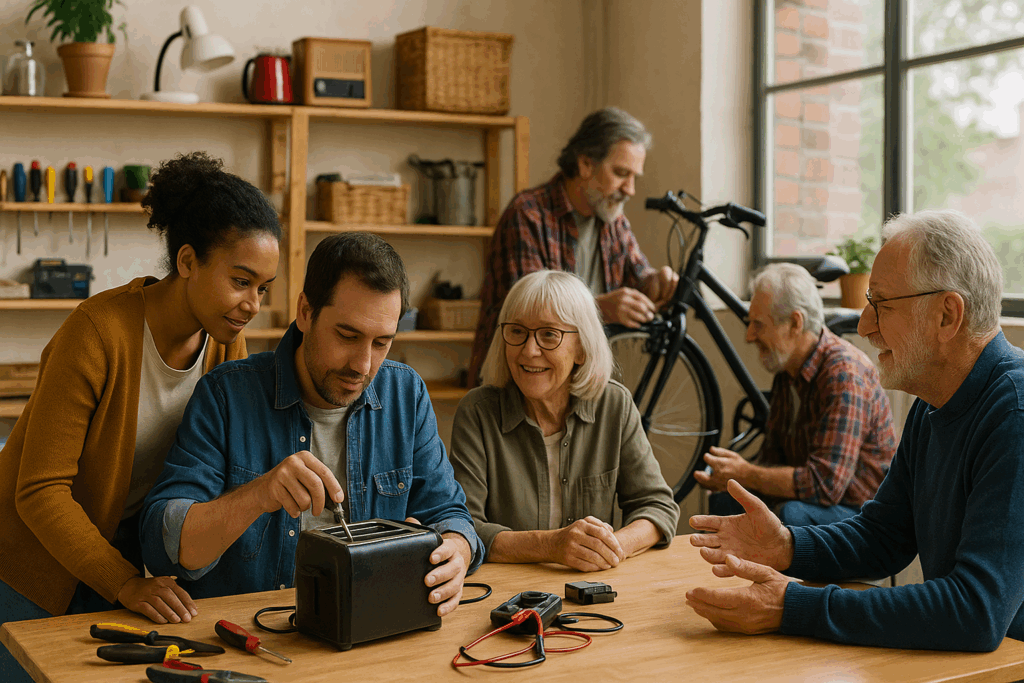Got a broken toaster collecting dust in the garage? A phone with a smashed screen you’ve been meaning to “deal with later”? You’re not the only one.
Plenty of Australians toss perfectly repairable items straight into the bin without knowing there’s another option. These items ultimately contribute to our growing e-waste crisis.
The solution? Repair Cafes.
Repair cafes offer free community workshops where volunteer fixers tackle electronic waste, home appliances, clothing, and furniture. These spaces are built to help you fix instead of toss.
In this guide, we’ll walk you through what happens at repair cafes, what items get fixed often, and how to find or start one in your town. Along the way, you’ll save money, keep waste out of the landfill, and support the right to repair movement.
Stay with us to learn how it all works.
Inside a Repair Cafe: From Check-In to Repair
Repair cafes are free community spaces where volunteers fix broken items, free of charge. You walk in, hand over your item to a volunteer, and they assess if it’s repairable.
While you wait, you’ll notice workbenches covered in tools and electronics, with fixers working on everything from phones to coffee makers. The process is simple from arrival to pickup.

Here’s what happens from check-in to collection:
How the Check-In Works
Start by handing over your item and explaining the problem. A volunteer will then examine it and give you an honest assessment of whether it’s fixable.
You won’t face any pressure or sales tactics here. They work on everything from vintage radios to current-model phones and computers. If repair isn’t possible, they’ll explain why in a way that doesn’t make you feel guilty about contributing to e-waste.
Meet Your Fixers
You might be wondering who does these repairs. They’re mostly retired tradespeople and tech hobbyists who enjoy the challenge. They often source spare parts from donations, salvaged electronics, or quick online orders.
Their motivation? Helping consumers fix things rather than watching repairable items become waste.
Your Role During Repairs
Drop-and-leave doesn’t happen here. Instead, you’ll stay and watch as volunteers work on batteries, screens, or broken components and explain each step clearly.
So ask questions whenever something interests you. You’ll learn techniques to use next time on phones, computers, or small appliances, and you’ll walk out with your fixed item within hours.
Pro tip: Bring any chargers or instruction manuals you still have, as they make repairs faster and easier.
Common Repairs From E-Waste to Household Items
Repair cafes accept nearly any broken item you bring through their doors. The workshops handle items of all sizes, ranging from tiny phone components to bulky furniture.

Volunteers regularly work on these three categories:
- Electronic waste tops the list:
Mobile phones tops the e-waste pile, often discarded with cracked screens or dead batteries. In 2019, Australia produced 511,000 tonnes of e-waste, about 20kg per person compared to the 7kg global average.
These devices contain toxic materials that leak into the soil when dumped. Fortunately, repairing phones and computers keeps valuable materials out of landfill and reduces the demand for new mining and manufacturing.
- Home appliances avoid becoming waste:
At community drop-off points, toasters, kettles, vacuum cleaners, and coffee machines arrive regularly for repair. And most of them only need small fixes like new cords, switches, or heating elements.
While manufacturers encourage buying new ones, volunteers show that repair is often the better choice. In fact, replacing a toaster’s heating element takes just 15 minutes and keeps it out of the landfill.
- Other items find new life, too:
Chairs stop wobbling after quick fixes, torn jeans and stuck zippers are mended in minutes, and drawers slide smoothly again with simple repairs. Even bikes get proper tune-ups.
Together, these small actions show how repair culture now extends beyond electronics and gives nearly every broken item a second chance.
Your broken item likely fits one of these categories, so don’t toss them just yet.
Why Repair Cafes Help Human Health and the Planet
Repair cafes prevent toxic e-waste from harming human health and the environment. They reduce manufacturing pollution, save household money, strengthen communities, and support the right to repair movement.

Let’s break down how repair cafes create change across five key areas:
- Stops toxic e-waste from harming health: Lead, mercury, and other hazardous substances in electronic waste often leak into the soil from landfills. As these toxins spread, communities near disposal sites face growing health risks. Choosing to repair over disposal means we can keep these harmful chemicals contained and protect the environment.
- Reduces manufacturing pollution: Manufacturing new products requires companies to extract raw materials and operate polluting factories. But when you repair items, you eliminate the need for replacements. This simple choice reduces your carbon footprint with every fix.
- Keeps money in your pocket: Consider the cost difference between repairing items and buying new ones. You’ll most likely find that simple fixes can keep products running for years or even decades. The Australian government also promotes repair as a cost-effective alternative to constant replacements.
- Connects communities together: Skills naturally transfer between generations at repair cafes. Through our research into community repair initiatives, shared problem-solving reduces isolation and builds lasting relationships. In these spaces, networks form around fixing rather than discarding.
- Empowers the right to repair: As international waste-reduction efforts gain traction, Australia is tightening its laws to protect and strengthen consumer repair rights. Even as manufacturers push back, consumers are reclaiming the right to repair and truly own their products.
Each fixed item proves that small choices create meaningful change for health and the planet alike.
Join the Repair Movement in Your Community
Australians discard thousands of tonnes of repairable items every year, adding more waste to landfills. In response, communities now run repair cafes where volunteers fix broken electronics, appliances, and furniture. This approach reflects Australia’s growing right to repair movement, which helps people choose fixing over throwing away.
This guide covered what happens inside repair cafes, common items volunteers fix, and the environmental benefits. You have also learned how repairs protect human health, reduce e-waste, save money, and strengthen communities while supporting consumer rights against manufacturers.
Ready to take action? Find your local repair cafe or start one in your town today. Visit Eco4theWorld for sustainability tips that move from awareness to action.
